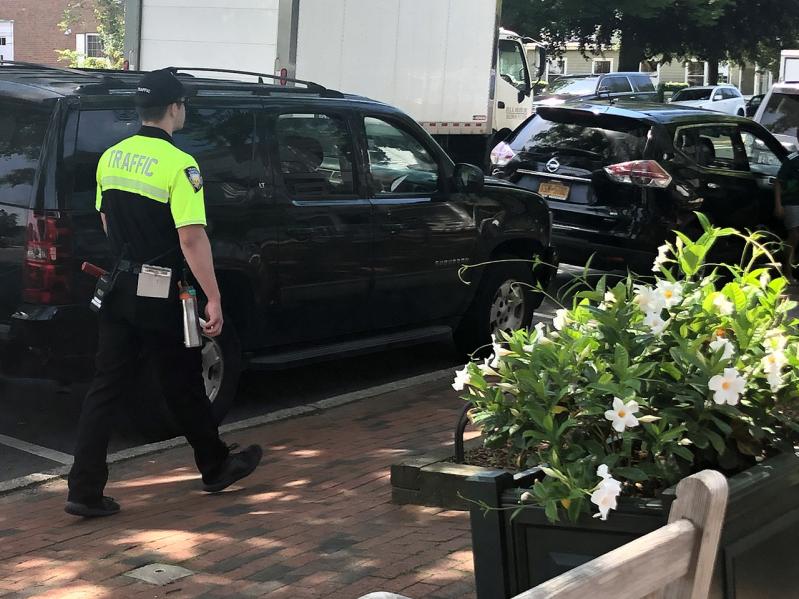Imagine a village with fewer empty stores in the off-season, with more cafes and affordable apartments in “bungalow courts.”
Those are a few of the potential changes a civil engineering firm hired by the East Hampton Village Board on Friday will explore as it develops plans to revitalize East Hampton Village’s commercial district, provide a sewage treatment system for the area, and increase parking and affordable housing.
The board accepted a $110,000 proposal from Nelson and Pope of Melville, which said it would begin by suggesting changes to the village’s zoning code and recommending other initiatives that would “encourage year-round vibrancy in the commercial areas.”
The firm’s proposal subdivides the village into seven distinct commercial zones: the village center, which includes the businesses surrounding the Reutershan parking lot, as well as those on both sides of Main Street and lower Newtown Lane; Gingerbread Lane, Railroad Avenue, upper Newtown Lane, North Main Street, Pantigo Road, and Cove Hollow Road.
Many businesses in the village center close after the summer season, the proposal says, while vacancies are less frequent in the Railroad Avenue and Gingerbread Lane districts, and virtually nonexistent on upper Newtown Lane, Pantigo Road, Cove Hollow, and North Main Street. “Although there is less turnover in other districts,” it says. “The reduction in the population makes it challenging for businesses to survive.”
The company promised to work with the village to develop policies that would address the impact vacancies have on the character of the downtown. It suggested allowing for off-season pop-up shops, and requiring storeowners to feature the work of local artists or historical displays in the windows of vacant stores.
To lure the significant number of year-round residents to the commercial district during fall and winter, the proposal says, the village should offer “comprehensive and persistent” programming such as festivals, art installations, book and poetry readings, and wellness workshops.
The village board has been discussing the need for a sewage treatment facility in the commercial area for months. Without a system that can handle further density and reduce the nitrogen that adversely affects ground and surface waters, board members have said they cannot safely bring new restaurants and other businesses into the district, nor can they provide more affordable housing by increasing the number of second-story apartments on Newtown Lane and Main Street.
To pave the way for such a facility, Nelson and Pope say they will initially do a study of the sanitary flow of the area based on existing businesses and proposed ones.
The company’s main objective will be to suggest cost-effective systems that will accommodate the need for increased sewage treatment. It will also recommend systems that can be phased in gradually.
“With a phased approach, the team may consider the use of small-scale innovative technologies to augment the conventional sewage disposal options,” the proposal states. “This will provide flexibility for wastewater solutions prior to the final system being completed.”
Ultimately, Nelson and Pope will present the village with a “feasibility report” on various options for a sewage treatment facility. The report will include construction costs, as well as the costs of operating and maintaining it over 25 years. The company will also look into developing a facility to be used jointly by East Hampton Town and the village, and it will identify areas in the town and near the village where it can be built.
Nelson and Pope proposes to inventory existing work force housing in the village and, with the help of the village’s Building Department, identify suitable units that have been lost over the years. It will also identify potential areas for new housing, and suggest zoning code changes that would allow for it.
Seeking to develop what it refers to as “missing middle housing,” that is, affordable residences in neighborhoods close to businesses and transportation, the company will provide the village with proposals to build duplexes, “fourplexes,” and bungalow courts (several small houses built around a central garden).
“Several of these housing types could work well in the Village of East Hampton, and it is expected that, when integrated with other commercial uses, would be well received by the residents of the village,” the proposal says.
The company’s preliminary analysis of the village’s parking and traffic challenges has found that congestion and lack of parking space in the village center during the summer season is predominantly due to a few high-use businesses such as the movie theater, the Stop and Shop grocery store, and Chase Bank.
The Gingerbread Lane district, it says, is zoned for manufacturing but contains several commercial businesses that have off-street parking areas that do not provide the number of spaces required by village code.
On the bright side, the shops on North Main Street, the proposal says, attract a significant number of customers, and the parking lot behind the I.G.A. there, as well as one at the municipal parking lot at the Emergency Services Building “appear to reduce the stresses for parking.”
Nelson and Pope will conduct a parking and traffic circulation study of the area, and develop measures to optimize parking. According to the proposal, some of those measures may include encouraging remote parking for business owners and employees, valet parking services, electronic monitoring of parking stalls, and the use of a smartphone app to alert drivers to available parking.
Initial reports on all elements of the project — parking and traffic, the sewage treatment facility, work force housing, and zoning changes — will be drafted concurrently, the company says. It expects the studies to be complete in six months.

